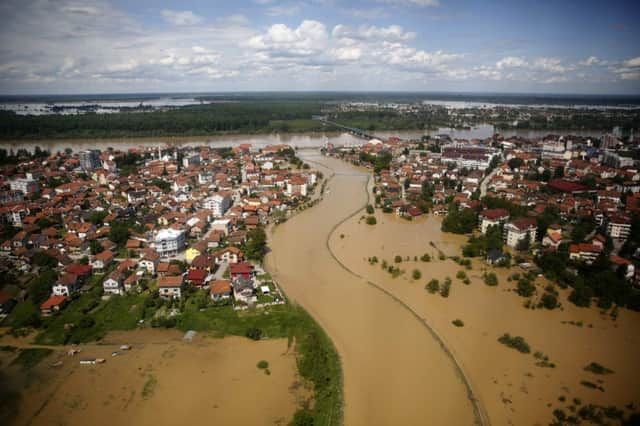At least 30 dead after landslides in Bosnia


Thousands more fled their homes in neighbouring Croatia and Serbia as Balkan countries battled the worst flooding since modern records began..
About 300 landslides have been reported, destroying roads, homes and entire villages. Helicopters were being used to evacuate stranded villagers.
Advertisement
Hide AdAdvertisement
Hide Ad“This is a catastrophe,” said Bosnia’s refugee minister, Adil Osmanovic.
The amount of rain expected to fall in three months fell in a three-day burst last week, causing the worst floods since records began 120 years ago.
Observed from the air, almost a third of Bosnia resembles a huge muddy lake, with houses, roads and rail lines submerged. Officials say about a million people – more than a quarter of the population – live in the worst-affected areas in the north-east.
The hillside village of Horozovina, close to Tuzla, was cut in two by a landslide that swallowed eight houses. More than 100 others were under threat from further landslips. “I am homeless. I have nothing left, not even a toothpick,” said one resident, Mesan Ikanovic. “I ran out of the house barefoot, carrying my children in my arms.”
Mr Ikanovic said he carried his seven-year-old daughter and four-year-old son to safety before the house was engulfed by a landslide.
Semid Ivilic’s house in the lower part of the village was still standing. But as he looked upward at the mass of earth and rubble that engulfed his neighbours’ homes, Mr Ivelic said he was worried. “Nobody is coming to help us,” he said.
He described the moment the landslide occurred. “It sounded like a huge explosion. People started running out of houses, screaming,” he said.
While water levels are receding in some parts of Bosnia, land flanking the Sava River remains submerged, and water levels are still rising.
Advertisement
Hide AdAdvertisement
Hide AdThe town of Orasje faces a major emergency as it is lies between the Sava and the River Bosna, which has also breached its banks.
More than 10,000 people have been rescued from the north-east town of Bijeljina. Lorries, buses and private cars were yesterday heading north with volunteers and tonnes of aid collected by people in cities outside the disaster zone.
In Sarajevo, volunteers went door-to-door collecting whatever people would donate.
The Bosnian army said it was evacuating people with helicopters and has 1,500 troops on the ground. But many roads remain closed by floods and hundreds of landslides.
Bridges have been washed away leaving many towns and villages dependent on supplies being helicoptered in.
Helicopters from the European Union, Slovenia and Croatia are also aiding rescue efforts in areas around five cities in central and north-east Bosnia.
In the east of neighbouring Croatia, two people are missing and hundreds have fled their homes as the Sava also breached flood barriers there.
In Serbia, more than 20,000 people have been forced from their homes. Officials there feared more flooding late yesterday as floodwaters travel down the Sava.
Advertisement
Hide AdAdvertisement
Hide AdSerb officials said the floodwater broke barriers upstream in Croatia and Bosnia. Experts expect Sava floodwaters to rise for two days before subsiding.
“What happened to us happens not once in 100 years, but once in 1,000 years,” Serbian prime minister Aleksandar Vucic said in a television broadcast. “But it should be over by Wednesday.”